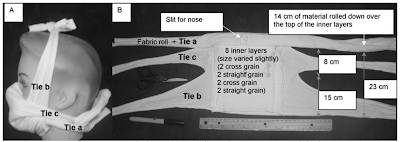Since there is a worldwide shortage of mass=produced masks, various governments have been encouraging their citizenry to make their own masks as part of the mandatory public masking to save us all from a COVID fate worse than death. It seems to be a viable option given the current pandemic and the lack of readily available masks, however, a study from 2010 would suggest otherwise.
A rather prescient study from June 2010 entitled "Simple Respiratory Protection – Evaluation of the Filtration Performance of Cloth Masks and Common Fabric Materials Against 20 – 1000nm Size Particles" by Samy Rengasamy et al looks at how readily available fabrics can be used to block aerosols at two different velocities and then compares the results to the penetration levels of N95 respirator filter media. The authors note that, in 2006, the CDC predicted that the demand for disposable N95 respirators by healthcare workers could exceed 90 million for a 42 day-long outbreak of influenza. This would result in a significant shortfall of N95 respirators for non-healthcare workers, necessitating the use of alternatives.
The authors tested the 3 samples of the various materials for NaCl polydisperse aerosols (75 nm +/- 20 nm median diameter and used both 5.5 cm per second and 16.5 cm per second face velocities. This is a common testing protocol for filtration performance testing and allows comparisons to standard filters including N95 respirators. Initial penetration levels of the NaCl particles were measured for one minute. Percentage penetration was calculated as the ratio of particle concentration downstream to upstream multiplied by 100.
Using the polydisperse method, the authors found the following penetration levels at the 5.5 cm per second face velocity:
N95 respirator – 0.12 percent
Hanes 100 percent cotton sweatshirt – 40 percent
Norma Kamali Tunic 85 percent cotton/15 percent polyester – 70 percent
Hanes 100 percent cotton T-shirt – 86 percent
Pem America 100 percent cotton towel – 63 percent
Today's Gentleman 100 percent cotton pocket square scarf – 90 percent
The authors found the following penetration levels using the 16.5 cm per second face velocity:
N95 respirator – less than 5 percent
Hanes 100 percent cotton sweatshirt – 57 percent
Norma Kamali Tunic 85 percent cotton/15 percent polyester – 82 percent
Hanes 100 percent cotton T-shirt: 88 percent
Pem America 100 percent cotton towel – 64 percent
Today's Gentleman 100 percent cotton pocket square scarf – 89 percent
The results of the study show that cloth masks created from various fabric materials had far higher penetration levels when challenged with polydisperse NaCl aerosols at both 5.5 cm per second and 16.5 cm per second face velocities. The authors note that the use of fabric materials "...may provide only minimal levels of respiratory protection to a wearer against virus-size submicron aerosol particles (i.e. droplet nuclei)". This is because fabric materials show marginal filtration performance against virus-sized particles even when they are sealed around the edges. As well, face seal leakage will result in decreased respiratory protection, a problem with homemade masks since they are generally loosely held around the margins of the mask.
Here is the authors' conclusion:
"Common fabric materials and cloth masks showed a wide variation in penetration values for polydisperse (40–90%) at 5.5 cm per second face velocity…. The penetration values obtained for common fabric materials indicate that only marginal respiratory protection can be expected for submicron particles taking into consideration face seal leakage." (my bold)
But, on the upside, the Centers for Disease Control and Prevention does have a "simple respiratory mask" made from a Hane's Heavyweight 100% cotton preshrunk T-shirt that it claims can "…provide a good fit and a measurable level of protection…" as shown on this diagram:
Given that the 2010 Regasamy et al study was completed well before the current pandemic thus removing any bias that government narratives currently employ to cajole us into masking up, it would appear that homemade cloth filters are providing Main Street with a false sense of protection against the SARS-CoV-2 virus unless people are willing to go to the lengths necessary to fabricate a CDC-approved design.
Click HERE to read more from this author.
You can publish this article on your website as long as you provide a link back to this page.


Be the first to comment